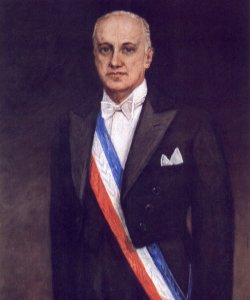- Jorge Alessandri
Infobox_President | name=Jorge Alessandri
nationality=Chilean

order=27thPresident of Chile
term_start=November 3 1958
term_end=November 3 1964
predecessor=Carlos Ibáñez
successor=Eduardo Frei Montalva
birth_date=birth date|1896|5|19|mf=y
birth_place=Santiago
death_date=death date|1986|8|31|mf=y
death_place=Santiago,Chile
spouse=none
party=Conservative Independent
vicepresident=Jorge Alessandri Rodríguez (
May 19 ,1896 –August 31 ,1986 ) was President ofChile from 1958 to 1964, and was the candidate of the centre-right in Chile's crucial presidential election of 1970. He was the son of Arturo Alessandri, who was president from 1920 to 1925 and again from 1932 to 1938.Early years
Born in Santiago, Alessandri studied
civil engineering at theUniversity of Chile in Santiago and after graduating in 1919 worked there as a lecturer. After the fall of the parliamentary republic, he lived inEurope anexile with his parents from 1924-1925, but returned to his native land where he was elected to parliament as an independent from a Santiago constituency in 1926.He withdrew from public life in 1932 to concentrate on business interests, becoming president of the
mortgage bank , "Caja de Crédito Hipotecario" until 1938 and running the "Paper and Carton Manufacturing Company". From 1944 to 1947, he was chairman of the Chilean employers' confederation.Return to politics
The early years of the right-wing Presidency of Gabriel González were marked by serious unrest between left and right-wing supporters, and on
2 August ,1947 González named a cabinet of military officers and independents in a supposed attempt to depoliticise the situation. Alessandri was named Minister of Finance, where he reordered the system of administration and pursued a rigorous programme of austerity.By 1950, he had restored order to the public finances and controlled
inflation . However, his freezes ofpublic sector remuneration gradually led to greater industrial unrest. Public sector workers came out on strike at the end of January 1950, which rapidly turned into a broad opposition against the government's economic policies. Along with the rest of the cabinet, Alessandri resigned on3 February , and returned to his role as president of the employers' confederation.enate and presidency
In 1956, the Liberal Party selected him as a candidate for a Santiago Senate seat, which he won with a substantial majority in 1957. However, Alessandri was seen as rather conservative by the Liberal Party, and in the end it was the moderate wing of the Conservative Party which secured his position as an independent candidate for the Presidency, with his campaign majoring on his economic expertise.
In March 1958, he edged the united left candidate for the Presidency,
Salvador Allende by 32.2% to 28.5%, with Christian DemocratEduardo Frei Montalva polling 20.5%. In the event of no candidate securing an overall majority of the popular vote, the choice of president fell to Congress, which duly chose Alessandri, who had a coalition of Conservatives, Liberals and Radical Party congressmen behind him.Alessandri initially focused, unsurprisingly, on economic issues, particularly on controlling inflation and balancing the state budget, and he liberalised Chile's tariff régime. However, he once again froze public sector pay, unleashing widespread industrial unrest.
In May 1960, a strong
earthquake struck the densely populated area between Concepción andPuerto Montt , causing more than USD 400 million in damage. Reconstruction and relief soon drowned out other issues.In 1961, elections to Congress saw massive losses for the Conservatives and Liberals, with the Radicals, alone of the coalition parties, doing well. This forced Alessandri to nominate more Ministers from the Radical Party, which in turned moved his government to the left. This tied in with the more activist foreign development policy pursued by
John F Kennedy in the wake of theCuban Revolution of 1959, in the shape of theAlliance for Progress . Together, these unleashed a wave of progressivetax and agricultural reforms. Despite this, distribution of land ownership remained grossly unequal.Alessandri's period of office ended in 1964, and he was succeeded by his
Christian Democrat opponent of 1958, the centistEduardo Frei Montalva . Alessandri returned to managing his paper factory.Allende's election and Pinochet's dictatorship
In 1970, following the end of Frei's period in office, Jorge Alessandri sought election as President once again, with his main opponent Salvador Allende, just as in 1958. After another close contest, Allende emerged in front this time, by the narrow margin of 37.3% to 35.8%, with Christian Democrat
Radomiro Tomic polling 27.9% on polling day,4 September . As in 1958, the election went to Congress, this time on24 October . Although Congress placed a number of conditions on Allende such as his signature of a "Statute of Constitutional Guarantees", promising not to undermine the Chilean Constitution, Alessandri lost the final vote by a decisive 153-35, with Tomic's Christian Democrats supporting Allende.After the military coup of
11 September ,1973 the government of military dictator GeneralAugusto Pinochet seized power, and in 1976 Alessandri was named President of a newly formed Council of State whose job was to create a new constitution. The Council of State's draft constitution was edited by the Junta. Alessandri did not agree with some of the Junta's authoritarian amendments and resigned from the Council. The constitution was approved in a nationalplebiscite held in September 1980 and came into force in March 1981. During the campaign, Alessandri declared he would vote "Yes", despite his disagreements with the Junta.Final years
After this, Jorge Alessandri once more withdrew into private life, now for the last time, living rather peacefully in his apartment in the center of Santiago. He continued to be
chairman of the board of a paper factory until his death in Santiago in 1986. He did not survive to see end of the junta and the return of Chile to democracy.His nephew
Arturo Alessandri Besa stood as Presidential candidate for the right-wing Alianza in 1993, losing to the Christian DemocratEduardo Frei Ruiz-Tagle of the Concertación center-left coalition.ee also
*
Alessandri family
Wikimedia Foundation. 2010.
